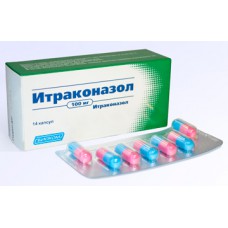Expiration date: 07/2025
Therapeutic agents Itraconazole: antifungals
Characteristic Itraconazole substance
Antifungal triazole derivatives of the group. White or slightly yellowish powder. Insoluble in water, very slightly soluble in alcohol, easily soluble in dichloromethane. Lipophilic, distribution coefficient (octanol / water at pH 8,1) - 5,66. Molecular Weight - 705.64.
Pharmacology
Mode of action - broad-spectrum antifungal.
in vitro studies have demonstrated that itraconazole inhibits the cytochrome P450-dependent synthesis of ergosterol - a necessary component of the cell membrane of fungi.
It is active against dermatophytes (Trichophyton spp., Microsporum spp., Epidermophyton floccosum), yeast-like fungi Candida spp. (Including C.albicans, C.glabrata, C.krusei), fungi (Cryptococcus neoformans, Aspergillus spp., Histoplasma spp., Paracoccidioides brasiliensis, Sporothrix schenckii, Fonsecaea spp., Cladosporium spp., Blastomyces dermatitidis), and others.
The bioavailability of itraconazole ranges in the range 40-100%, depending on the dosage form, and reception conditions.
Pharmacokinetics after itraconazole / v administration and the absolute bioavailability when administered as a solution have been studied in a randomized crossover study in 6 healthy male volunteers, the observed bioavailability was 55% taking into solution. Bioavailability was higher when taking fasting solution: in 27 healthy male volunteers h AUC0-24 values ??at equilibrium when receiving fasting were 131 ± 30% of that observed in the reception after a meal.
The bioavailability of itraconazole capsules is maximal when taking the capsules immediately after a heavy meal. The crossover study in 6 healthy male volunteers who received itraconazole capsules in a single dose of 100 mg immediately after nourishing meal or without, Cmax was 132 ± 67 ng / ml and 38 ± 20 ng / ml, respectively. Absorption of itraconazole on an empty stomach is variable and depends on the level of intragastric acidity (relative or absolute achlorhydria). It noted reductions in bioavailability in patients with AIDS, as well as volunteers who received gastric secretion suppressors (eg H2-antihistamines) and absorption - when taking itraconazole capsules at the same time with cola. The cross-over study in 18 patients with AIDS showed that when receiving 200 mg itraconazole simultaneously on an empty stomach with cola (compared with the reception of the same amount of water) AUC0-24 values ??increased to 121 ± 75%, Cmax increased by 128 ± 95%.
Cmax is reached within 3-4 hours, the equilibrium concentration in plasma (when assigning 100-200 mg 1-2 times a day) - 15 days and amounts (3-4 h after the last dose): 0.4 g / ml (while taking 100 mg 1 time per day), 1.1 ug / ml or 2 mg / ml (200 mg of 1 or 2 times per day). Binding to plasma proteins - 99.8% (itraconazole), 99.5% (gidroksiitrakonazol). It penetrates the tissues and organs (including the vagina), is contained in the secretion of sebaceous and sweat glands. Accumulates in the lungs, kidneys, liver, bone, stomach, spleen, skeletal muscle (itraconazole concentration in these tissues than in plasma of 2-3. Concentrations of keratin tissues, especially the skin, is 4 times greater than plasma. Itraconazole is found in nail keratin within 1 week after initiation of treatment and stored for at least 6 months after 3 months of treatment, the skin -. within 2-4 weeks after 4 weeks Poor reception Biotransformiroetsa passes through BBB in liver (preferably with participation. . CYP3A4) to form a large number of metabolites, including the active (gidroksiitrakonazola) excreted by the kidneys (less than 0.03% unchanged, about 40% - in the form of inactive metabolites), and faeces (3-18% unchanged ). In patients with renal insufficiency bioavailability slightly reduced as compared to patients with normal renal function. patients with cirrhosis increased T1 / 2.
Reduced heart contractility
The on / in the introduction of itraconazole anesthetized dogs was observed dose-dependent negative inotropic effect. In a study in healthy volunteers in / itraconazole injection resulted in transient, asymptomatic decrease in left ventricular ejection fraction (until the next infusion - 12 hours - these changes disappeared).
Application of the substance Itraconazole
Fungal infections of the skin, mucous membranes of the mouth and eyes, onychomycosis caused by dermatophytes, yeasts and molds, candidiasis of the skin lesions and mucous membranes, including vulvovaginal candidiasis, pityriasis versicolor, systemic mycoses, including aspergillosis (with resistance or poor tolerability of amphotericin B), cryptococcosis (including cryptococcal meningitis), histoplasmosis, sporotrichosis, paracoccidioidomycosis, blastomycosis.
Contraindications
Hypersensitivity.
Restrictions apply
Chronic heart failure, including history (use is possible only in cases where the expected benefit outweighs the potential risk), liver cirrhosis, renal failure, children's age (safety and efficacy of the children are not identified).
Pregnancy and breast-feeding
Application of pregnancy is permitted only in systemic mycoses in cases where the expected effect outweighs the potential risk to the fetus.
Category effects on the fetus by FDA - C.
Nursing mothers should avoid breastfeeding (Itraconazole passes into breast milk).
Side effects of substance Itraconazole
From the digestive tract: dyspepsia, nausea, abdominal pain, anorexia, vomiting, constipation, increased activity of hepatic transaminases, hepatitis, in very rare cases - severe liver toxicity, including case of acute liver failure with fatal consequences.
From the nervous system and sensory organs: headache, dizziness, peripheral neuropathy, fatigue, drowsiness.
Cardio-vascular system and blood (blood, hemostasis): hypertension. It reported cases of congestive heart failure associated with the reception of itraconazole.
With the genitourinary system: dysmenorrhea, edema syndrome, albuminuria, urine staining in a dark color.
Allergic reactions: itching, rash, urticaria, angioedema, Stevens - Johnson.
Other: alopecia, hypokalemia, pulmonary edema, decreased libido, impotence.
Interaction
Incompatible with terfenadine, astemizole, cisapride, lovastatin, oral midazolam and triazolam forms. Amplifies and / or prolong the effect of oral anticoagulants (including warfarin), cyclosporine, digoxin, methylprednisolone, vincristine, calcium channel blockers. Rifampicin and phenytoin decrease the bioavailability of itraconazole, inhibitors of the cytochrome CYP3A4 (ritonavir, indinavir, clarithromycin) increases its bioavailability. Antacids reduce the absorption of itraconazole (interval separating their intake should be at least 2 hours).
Overdose
Treatment: gastric lavage, activated charcoal, symptomatic therapy. Not removed during hemodialysis. No specific antidote.
Dosing and Administration
Inside, after eating (capsule), fasting (oral solution). Onychomycosis - 200 mg 1 time per day for 3 months or 200 mg 2 times daily for 1 week followed by a break 3 weeks, with onychomycosis stop 3 recommended course of treatment, brushes - 2 courses, vulvovaginal candidiasis - 200 mg 2 during times of the day or one 200 mg 1 time per day for 3 days, pityriasis versicolor - 1 200 mg once a day for 7 days, ringworm and oral candidiasis - 100-200 1 mg once a day during 7-15 days (if necessary, repeat), fungal keratitis - 1 200 mg once a day for 21 days, systemic mycoses - 100-200 mg 1-2 times a day for 2-12 months (depending on the pathogen).
Precautions substance Itraconazole
In patients with impaired immunity (AIDS, a condition after organ transplantation, neutropenia) an increase in dose may be necessary (due to decreased bioavailability of itraconazole).
When administered to patients with chronic heart failure requires an individual assessment of benefit-risk ratio, taking into account factors such as the seriousness of the indications, dosage regimen and individual risk factors (the presence of heart disease, including ischemic heart disease, valvular disease), chronic obstructive pulmonary disease, renal failure. If you have any signs or symptoms of congestive heart failure, and neuropathy treatment with itraconazole should be discontinued.
In the course of treatment with itraconazole is necessary to monitor liver function (especially for chronic administration). When elevated levels of transaminases appointed, if the effect of therapy outweighs the potential risk of liver injury. Patients with cirrhosis of the liver and / or renal function must be monitored in plasma concentration of itraconazole and adjust the dosage if necessary.
Women of childbearing age should use adequate contraception methods during the entire course of treatment, until the onset of the first menstrual period after its completion.


